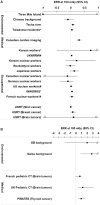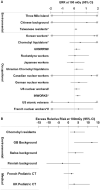Epidemiological Studies of Low-Dose Ionizing Radiation and Cancer: Rationale and Framework for the Monograph and Overview of Eligible Studies
- PMID: 32657348
- PMCID: PMC7610154
- DOI: 10.1093/jncimonographs/lgaa009
Epidemiological Studies of Low-Dose Ionizing Radiation and Cancer: Rationale and Framework for the Monograph and Overview of Eligible Studies
Abstract
Whether low-dose ionizing radiation can cause cancer is a critical and long-debated question in radiation protection. Since the Biological Effects of Ionizing Radiation report by the National Academies in 2006, new publications from large, well-powered epidemiological studies of low doses have reported positive dose-response relationships. It has been suggested, however, that biases could explain these findings. We conducted a systematic review of epidemiological studies with mean doses less than 100 mGy published 2006-2017. We required individualized doses and dose-response estimates with confidence intervals. We identified 26 eligible studies (eight environmental, four medical, and 14 occupational), including 91 000 solid cancers and 13 000 leukemias. Mean doses ranged from 0.1 to 82 mGy. The excess relative risk at 100 mGy was positive for 16 of 22 solid cancer studies and 17 of 20 leukemia studies. The aim of this monograph was to systematically review the potential biases in these studies (including dose uncertainty, confounding, and outcome misclassification) and to assess whether the subset of minimally biased studies provides evidence for cancer risks from low-dose radiation. Here, we describe the framework for the systematic bias review and provide an overview of the eligible studies.
Published by Oxford University Press 2020. This work is written by US Government employees and is in the public domain in the US.
Figures



References
-
- United Nations ScientificCommittee on the Effects of Atomic Radiation (UNSCEAR). Summary of Low-Dose Radiation Effects on Health. New York: United Nations; 2011.
-
- National Research Council. Health Risks from Exposure to Low Levels of Ionizing Radiation (BEIR VII) Phase 2. Washington, DC: National Academies Press; 2006. - PubMed
-
- United Nations Scientific Committee on the Effects of Atomic Radiation. Sources and effects of ionizing radiation New York: United Nations; 2008.
-
- NCRP. Implications of Recent Epidemiologic Studies for the Linear-Nonthreshold Model and Radiation Protection. Bethesda, MD: National Council on Radiation Protection and Measurements; 2018.

